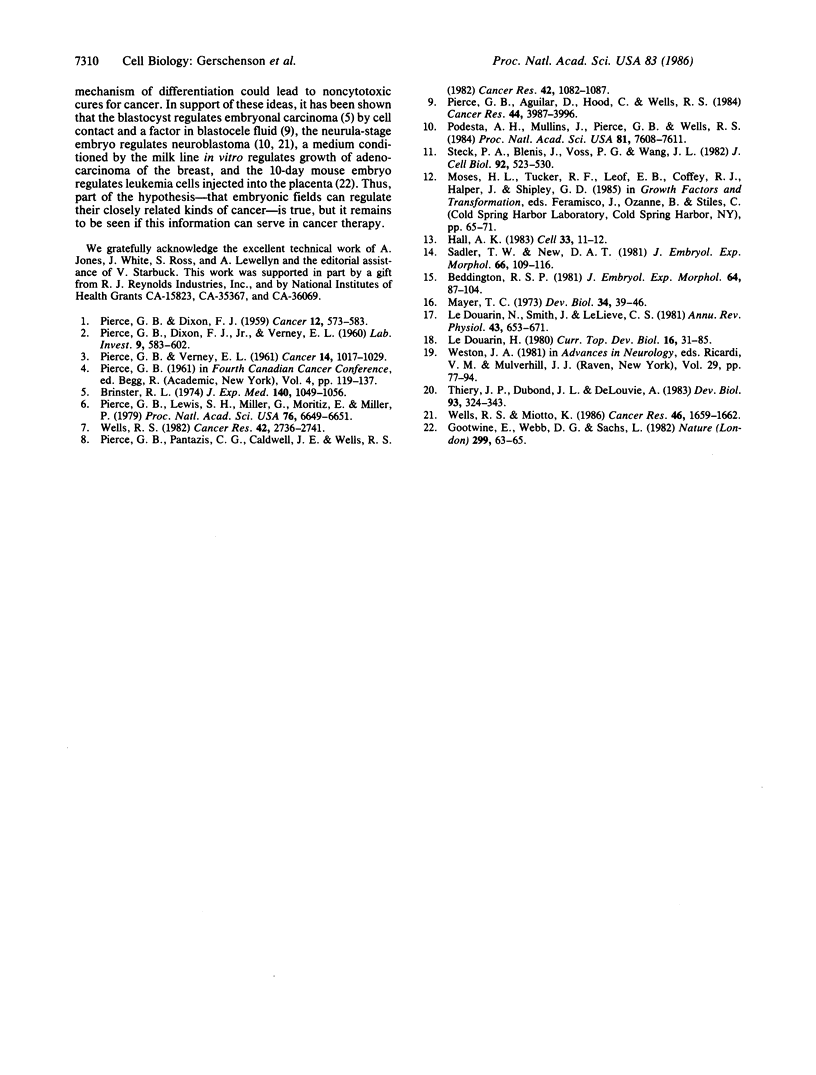Abstract
This report focuses on the regulation of murine melanoma by the embryonic skin. A surgical technique was developed to allow injection of B16 melanoma cells into the embryo in utero. A significant decrease in incidence of tumors was noted, which correlated with the time of arrival of normally migrating premelanocytes into the skin. Media were conditioned from skin explanted at the time premelanocytes arrive in it; these media inhibited the growth of melanoma cells in vitro. Under optimal conditions the growth of melanoma cells ceased; the cells had altered morphology and failed to proliferate when placed in fresh growth media.
Full text
PDF



Images in this article
Selected References
These references are in PubMed. This may not be the complete list of references from this article.
- Beddington S. P. An autoradiographic analysis of the potency of embryonic ectoderm in the 8th day postimplantation mouse embryo. J Embryol Exp Morphol. 1981 Aug;64:87–104. [PubMed] [Google Scholar]
- Brinster R. L. The effect of cells transferred into the mouse blastocyst on subsequent development. J Exp Med. 1974 Oct 1;140(4):1049–1056. doi: 10.1084/jem.140.4.1049. [DOI] [PMC free article] [PubMed] [Google Scholar]
- Gootwine E., Webb C. G., Sachs L. Participation of myeloid leukaemic cells injected into embryos in haematopoietic differentiation in adult mice. Nature. 1982 Sep 2;299(5878):63–65. doi: 10.1038/299063a0. [DOI] [PubMed] [Google Scholar]
- Hall A. K. Stem cell is a stem cell is a stem cell. Cell. 1983 May;33(1):11–12. doi: 10.1016/0092-8674(83)90328-8. [DOI] [PubMed] [Google Scholar]
- Le Douarin N. M., Smith J., Le Lièvre C. S. From the neural crest to the ganglia of the peripheral nervous system. Annu Rev Physiol. 1981;43:653–671. doi: 10.1146/annurev.ph.43.030181.003253. [DOI] [PubMed] [Google Scholar]
- Le Douarin N. Migration and differentiation of neural crest cells. Curr Top Dev Biol. 1980;16:31–85. doi: 10.1016/s0070-2153(08)60153-2. [DOI] [PubMed] [Google Scholar]
- Mayer T. C. The migratory pathway of neural crest cells into the skin of mouse embryos. Dev Biol. 1973 Sep;34(1):39–46. doi: 10.1016/0012-1606(73)90337-0. [DOI] [PubMed] [Google Scholar]
- PIERCE G. B., DIXON F. J., Jr Testicular teratomas. I. Demonstration of teratogenesis by metamorphosis of multipotential cells. Cancer. 1959 May-Jun;12(3):573–583. doi: 10.1002/1097-0142(195905/06)12:3<573::aid-cncr2820120316>3.0.co;2-m. [DOI] [PubMed] [Google Scholar]
- PIERCE G. B., Jr, DIXON F. J., Jr, VERNEY E. L. Teratocarcinogenic and tissue-forming potentials of the cell types comprising neoplastic embryoid bodies. Lab Invest. 1960 Nov-Dec;9:583–602. [PubMed] [Google Scholar]
- PIERCE G. B., Jr, VERNEY E. L. An in vitro and in vivo study of differentiation in teratocarcinomas. Cancer. 1961 Sep-Oct;14:1017–1029. doi: 10.1002/1097-0142(196109/10)14:5<1017::aid-cncr2820140516>3.0.co;2-p. [DOI] [PubMed] [Google Scholar]
- Pierce G. B., Aguilar D., Hood G., Wells R. S. Trophectoderm in control of murine embryonal carcinoma. Cancer Res. 1984 Sep;44(9):3987–3996. [PubMed] [Google Scholar]
- Pierce G. B., Lewis S. H., Miller G. J., Moritz E., Miller P. Tumorigenicity of embryonal carcinoma as an assay to study control of malignancy by the murine blastocyst. Proc Natl Acad Sci U S A. 1979 Dec;76(12):6649–6651. doi: 10.1073/pnas.76.12.6649. [DOI] [PMC free article] [PubMed] [Google Scholar]
- Pierce G. B., Pantazis C. G., Caldwell J. E., Wells R. S. Specificity of the control of tumor formation by the blastocyst. Cancer Res. 1982 Mar;42(3):1082–1087. [PubMed] [Google Scholar]
- Podesta A. H., Mullins J., Pierce G. B., Wells R. S. The neurula stage mouse embryo in control of neuroblastoma. Proc Natl Acad Sci U S A. 1984 Dec;81(23):7608–7611. doi: 10.1073/pnas.81.23.7608. [DOI] [PMC free article] [PubMed] [Google Scholar]
- Sadler T. W., New D. A. Culture of mouse embryos during neurulation. J Embryol Exp Morphol. 1981 Dec;66:109–116. [PubMed] [Google Scholar]
- Steck P. A., Blenis J., Voss P. G., Wang J. L. Growth control in cultured 3T3 fibroblasts II. Molecular properties of a fraction enriched in growth inhibitory activity. J Cell Biol. 1982 Feb;92(2):523–530. doi: 10.1083/jcb.92.2.523. [DOI] [PMC free article] [PubMed] [Google Scholar]
- Thiery J. P., Duband J. L., Delouvée A. Pathways and mechanisms of avian trunk neural crest cell migration and localization. Dev Biol. 1982 Oct;93(2):324–343. doi: 10.1016/0012-1606(82)90121-x. [DOI] [PubMed] [Google Scholar]
- Wells R. S. An in vitro assay for growth regulation of embryonal carcinoma by the blastocyst. Cancer Res. 1982 Jul;42(7):2736–2741. [PubMed] [Google Scholar]
- Wells R. S., Miotto K. A. Widespread inhibition of neuroblastoma cells in the 13- to 17-day-old mouse embryo. Cancer Res. 1986 Apr;46(4 Pt 1):1659–1662. [PubMed] [Google Scholar]






